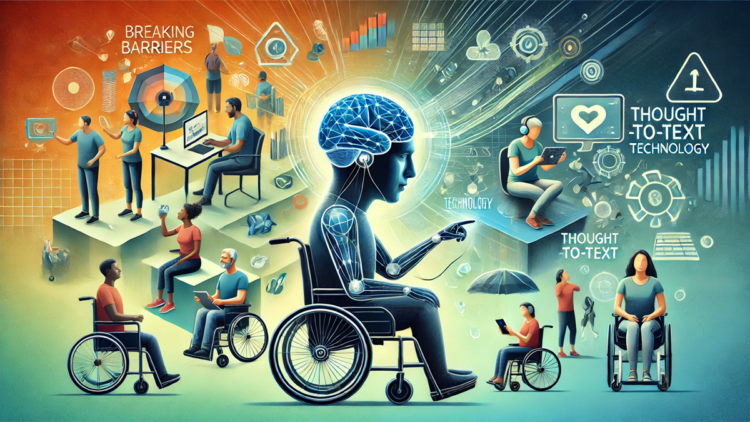

In a world increasingly reliant on fast, effective communication, millions of physically disabled individuals face daily challenges in expressing themselves. This gap in communication poses limitations not just for personal interactions but also in educational, professional, and social settings. However, advancements in neurotechnology offer new hope. One of the most exciting developments in this field is our research project, a “Thought-to-Text (T2T)” system designed specifically for physically disabled persons. This system leverages brain signals to control a virtual keyboard, offering an alternative method for communication that is both innovative and life changing.
The Motivation Behind Thought-to-Text Systems
For many individuals living with conditions such as ALS, spinal cord injuries, or severe neuromuscular diseases, traditional communication tools can be insufficient. Even advanced assistive technologies like eye-tracking devices or speech-generating systems may not be suitable or accessible for everyone. This research set out with one core goal in mind: to develop a solution that could provide a more intuitive and seamless experience, giving disabled persons the power to communicate their thoughts without the need for physical movement.
Our T2T system allows users to communicate via brain-typing, where electroencephalography (EEG) signals are used to move a cursor and select letters on a virtual keyboard. This kind of direct brain-computer interface (BCI) technology opens up new possibilities, giving individuals greater autonomy over their communication.
Research Gaps and Challenges in Brain-Computer Interfaces
Existing brain-typing systems, while promising, still face several limitations. For instance, many BCI systems struggle with speed, accuracy, or general usability. The challenge lies in extracting meaningful patterns from EEG signals, which are often noisy and complex. Furthermore, traditional models used for classifying EEG data, such as linear classifiers, are often inadequate for capturing both the spatial and temporal dependencies present in brain activity.
Despite advancements in the field, there is a significant gap when it comes to developing robust systems that can be both accurate and fast enough for real-time use. Previous models have faced issues with long typing times and relatively low classification accuracies, making them less practical for real-world applications. This is where our research steps in to push the boundaries.
Novelty of Our Approach
Our research tackles these challenges with a novel hybrid model that combines deep learning techniques and traditional machine learning classifiers to optimize both speed and accuracy. Specifically, our model integrates a convolutional neural network (CNN) for spatial feature extraction with a long short-term memory (LSTM) network for capturing temporal patterns in the EEG data. The hybrid CNN-LSTM model allows us to process complex, multidimensional EEG signals more effectively than either approach alone.

The features extracted by the CNN-LSTM model are fed into an XGBoost classifier, which has proven to be highly efficient in providing accurate classification of five distinct EEG tasks. By merging deep learning and traditional machine learning approaches, we were able to build a model that significantly improves upon previous systems.

The result? A real-time brain-typing system with a remarkable typing speed of 6 seconds per letter and an accuracy of 96.89%, outperforming many existing models in the field.
System Deployment and Real-Time Testing
One of the key aspects of our project was ensuring that the system could be used in real-time. To that end, we deployed our deep hybrid model on a local server, allowing users to test the system and experience the immediacy of brain-typing. The output from our model is used to move a cursor, allowing the user to select letters on a graphical user interface (GUI) screen. This interface is accessible from any platform or device, making it highly adaptable to different user environments.


Moreover, the deep hybrid model has been pickled, ensuring that the model can be quickly loaded and executed in real-time without the need for heavy computational resources. This deployment capability makes the system more practical and usable for disabled individuals in their day-to-day lives.

Achievements and Future Directions
Through rigorous testing and evaluation, we validated our system using confusion matrices and classification reports, fine-tuning the model’s hyperparameters to ensure maximum accuracy. We also plotted the model’s accuracy and loss over several epochs to analyze its performance and further optimize it for real-world applications.
This work has significant implications for the future of assistive technology. Our system not only achieves higher accuracy and faster typing speeds than current models but also demonstrates the potential of hybrid deep learning approaches in the realm of brain-computer interfaces. We believe that this is just the beginning. As technology continues to advance, so will the capabilities of systems like ours, offering more disabled individuals the opportunity to communicate with the world around them.
Conclusion
The development of a Thought-to-Text system using brain-typing technology marks a breakthrough in assistive communication tools. With our hybrid model and its real-time deployment, we are paving the way for individuals with physical disabilities to communicate more easily, with greater independence. Our work showcases the immense potential of deep learning and BCI systems to improve lives, and we look forward to seeing how this technology evolves to meet the needs of even more users in the future.
The author is an Associate Professor, at School of Electrical Engineering and Computer Science (SEECS), National University of Sciences and Technology (NUST). He can be reached at wajid.mumtaz@seecs.edu.pk.
Research Profile: https://bit.ly/4eTiwEB

![]()




